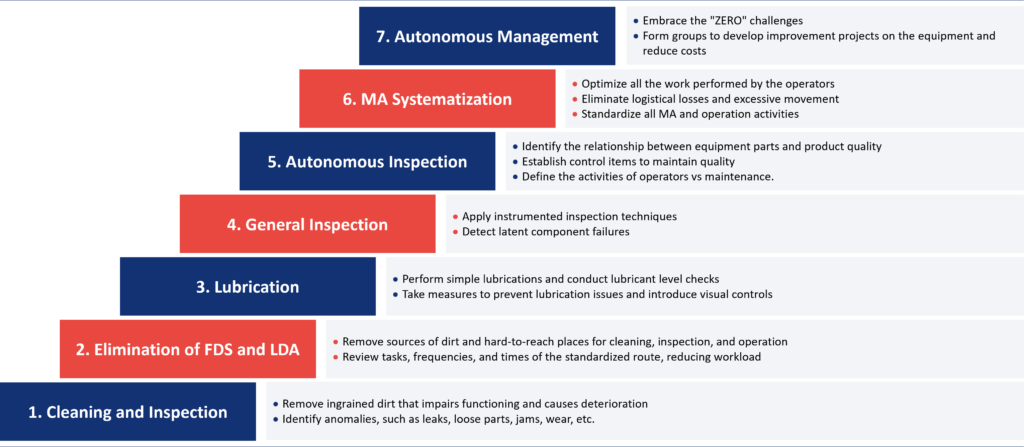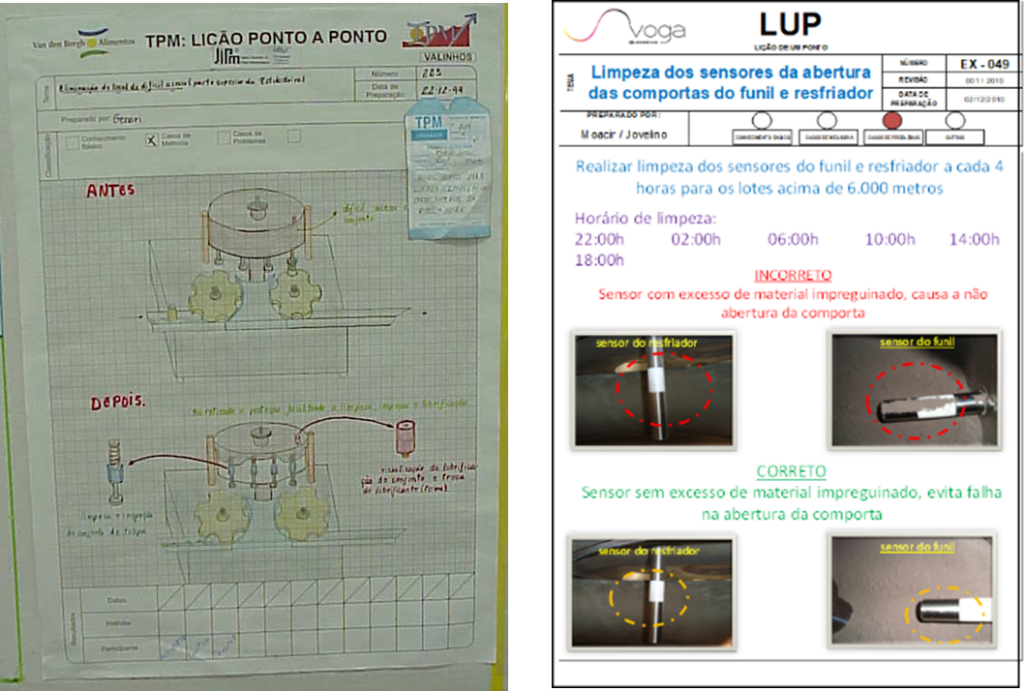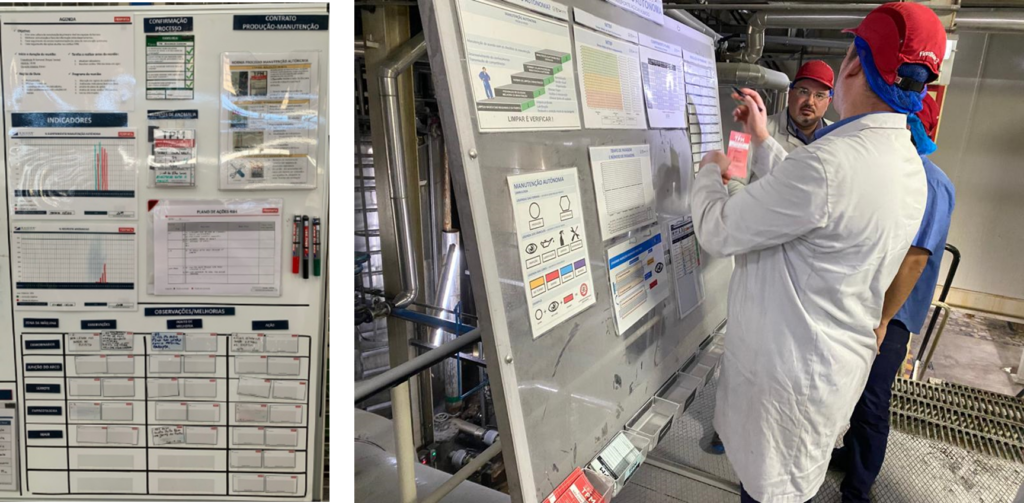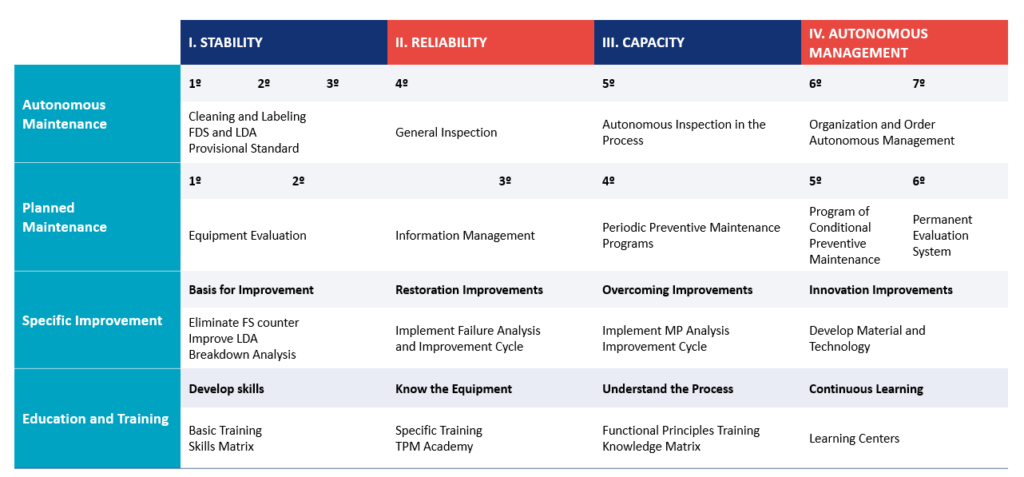
Subscribe To Receive Updates More Blogs!
In the current climate, where ensuring high quality, flexibility, speed, customization, and low production costs are demanding challenges, production systems play a fundamental role in organizations. Implementing Autonomous Maintenance (AM) emerges as a vital strategy in this situation.
Autonomous Maintenance is one of the foundations of Total Productive Maintenance (TPM) and involves production operators in equipment conservation and maintenance, fostering a culture of prevention where operators become the “owners” of the equipment, being responsible for monitoring their operational conditions and ensuring the preservation of their functions. This results in greater equipment reliability, reduction of failures, extended lifespan, decreased downtime, and overall improvement in operational performance.
Introduction to Total Productive Maintenance (TPM)
TPM originated in Japan, specifically in the automotive industry. The Japan Institute of Plant Maintenance (JIPM) developed the TPM concept in the early 1970s. The approach was initially introduced by the company Nippondenso, a member of the Toyota Group, as part of initiatives to enhance the efficiency and reliability of production equipment.
TPM is a comprehensive management and maintenance approach that aims to achieve maximum efficiency in an organization’s production system. TPM is based on the active participation of all company members, from top management to line operators, to eliminate losses and maximize the utilization of available resources, such as people, processes, and equipment, without the need for significant investments in new assets.
TPM seeks operational excellence, reducing downtime, improving product quality, increasing productivity, and maximizing the utilization of existing resources. TPM goes beyond conventional maintenance, involving all areas of the organization in a joint effort to improve overall performance.
The purpose of TPM is to achieve maximum efficiency in the production system through the elimination of losses. These losses include unplanned downtime, setup times, rework, quality defects, and low speed. It seeks to identify the sources of these losses and implement measures to eliminate them, promoting continuous improvement and increased operational efficiency.
By adopting TPM, organizations aim to establish a culture of proactive maintenance and shared responsibility, empowering operators to play an active role in equipment maintenance and improvement.
The Pillars of TPM
TPM is based on eight pillars, which are the foundations for eliminating losses and promoting continuous improvement in the organization.
1. Autonomous Maintenance:
Autonomous maintenance involves empowering and holding operators accountable for essential maintenance and equipment inspection. This pillar seeks to develop a culture of prevention, where operators become responsible for their equipment. Operators perform basic activities, such as cleaning, inspection, and simple lubrication, to prevent forced deterioration.
2. Specific Improvement:
Specific improvement refers to activities directed toward eliminating losses and process improvement. These multifunctional group activities enhance processes and eliminate chronic issues, aiming to increase equipment performance.
3. Planned Maintenance:
Planned maintenance aims to maximize equipment availability through efficient planning of maintenance activities. This involves scheduling inspections, preventive maintenance, and proper management of necessary resources. It is the responsibility of maintenance specialists.
4. Education and Training:
Training operators and other employees is fundamental to the success of TPM. This pillar focuses on developing the technical skills and knowledge of employees, providing appropriate training, and promoting awareness of TPM at all levels of the organization.
5. Quality Maintenance:
Product quality is directly related to equipment performance. This principle dictates that actions are implemented to ensure product quality through preventive maintenance, rigorous inspections, and data analysis to identify quality issues. It aims to establish conditions for the “zero defects” goal.
6. EEM – Early Equipment Management:
EEM ensures that maintenance needs are considered suitable from the equipment design phase. This pillar promotes collaboration between design engineers, and maintenance and production teams to create reliable and easily maintainable equipment.
7. Health, Safety, and Environment:
Safety and environmental care are essential aspects of any production process. This pillar focuses on practices and policies that ensure employee safety and environmental preservation, promoting a healthy and sustainable work environment.
8. Administrative Support Systems:
This principle establishes efficient administrative systems and processes that support the activities. This includes information and document management and integrating maintenance systems with other departments.
The leadership of AM workshops should be from the maintenance side. A multidisciplinary improvement maintenance team, consisting of the production manager, machine operators, maintenance manager, maintenance operators, and possibly quality or engineering team members, should be defined. In the workshop, it is essential to clarify who will be the team responsible for overseeing the operational conditions and preserving the equipment. This team should consist of at least two operators, who will be the “owners” of the equipment under their responsibility.
The main functions of this team are:
Monitoring Operating Conditions:
The AM team must conduct “on-site” checks of the main parameters of the equipment. This involves observing performance, operation, and other relevant indicators to ensure proper functioning. The obtained data should be recorded and published according to established standards.
Executing Tasks According to Standardized Routes:
The team must follow standard routes to carry out autonomous maintenance tasks. These routes contain detailed instructions on the actions to be performed, such as cleaning, inspection, lubrication, and other preventive maintenance activities. It is essential to record and report any defects found during the execution of these tasks.
Analyzing and Reporting on the Results:
The Autonomous Maintenance team must keep an eye out for deviations and anomalies in the equipment. If they find any, they should analyze the causes of these deviations and suggest appropriate solutions. This analysis is essential for identifying recurring problems, implementing improvements, and preventing future failures. The results and analyses should be presented periodically, according to the schedule established by the area.
Autonomous Maintenance allows operators to play an active role in the preservation and maintenance of the equipment, contributing to the maximization of performance.
Benefits of Autonomous Maintenance
Autonomous Maintenance plays a crucial role in increasing the efficiency of the production system. A mindset of prevention and shared responsibility is created by involving operators in the care and preservation of equipment. This results in greater equipment reliability, reduction of failures, increased lifespan, reduced downtime, and overall improvement in operational performance.
Here is more detail on the benefits of Autonomous Maintenance.
Increased Equipment Uptime
With Autonomous Maintenance, operators are empowered to identify problems early on, perform preventive maintenance activities, and execute routine tasks such as cleaning and lubrication. This results in a reduction of unplanned downtime, increasing equipment uptime.
Extended Equipment Lifespan
By involving operators in equipment maintenance, AM contributes to extending the lifespan of assets. Operators are more attentive to operating conditions, conduct regular inspections, and take measures to prevent excessive wear and damage to the equipment.
Improvement in Product Quality
Autonomous Maintenance contributes to ensuring product quality. Operators can identify and correct issues that might affect quality by conducting cleaning and inspection activities. This results in a reduction of defects and rework, improving the final quality of the product.
Better Resource Utilization
With Autonomous Maintenance, operators engage more with the equipment and develop a sense of responsibility. This leads to better utilization of available resources, such as materials, spare parts, and working time, avoiding waste and optimizing operational efficiency. Maintenance teams also free up availability for higher value-added technical activities (technical improvements, advanced preventive activities, planned maintenance, predictive analysis, structured failure analysis).
Improvement in Work Safety
AM contributes to creating a safer work environment. Operators involved in maintenance activities become more aware of the risks and necessary safety measures. This results in a reduction in accidents and equipment-related injuries.
Continuous Improvement
Autonomous Maintenance promotes a culture of continuous improvement. Operators constantly observe, analyze, and diagnose equipment, and offer solutions for identified problems and deviations. This leads to a learning cycle and continuous improvement, driving operational excellence.
In summary, Autonomous Maintenance brings significant benefits such as increased equipment uptime, extended lifespan, improved product quality, better resource utilization, increased work safety, and the promotion of continuous improvement. These benefits contribute to operational efficiency, cost reduction, and strengthening competitiveness.
Steps for Implementing Autonomous Maintenance
Autonomous Maintenance follows a set of seven well-defined steps. Below, we will highlight the importance of each step and how it contributes to operational excellence.

1. Cleaning and Inspection
The first step of Autonomous Maintenance involves cleaning and inspecting the equipment. The goal is for operators to become familiar with the equipment and better understand it, developing a sense of equipment ownership.
Main Activities to be Performed:
Eliminate embedded dirt that hinders operation and causes deterioration;
Identify anomalies such as leaks, loose parts, jams, wear, etc.
Equipment Objectives:
Establish the basic operating conditions of the equipment;
Expose and address hidden anomalies;
Prevent accelerated deterioration.
Role of Leaders:
Train to recognize what anomalies are;
Explain the relationship between dirt and accelerated deterioration;
Teach the meaning of inspecting through cleaning;
Show the critical parts of the equipment.
2. Elimination of Sources of Dirt and Hard-to-Reach Areas
In this stage, operators seek to identify and eliminate sources of dirt and hard-to-reach areas that may prevent proper equipment cleaning and inspection. Operators should learn simple methods for problem analysis, create “One Point Lessons” for minor improvements, and participate in group improvement projects.
Main Activities to be Performed:
Eliminate or reduce sources of dirt and hard-to-reach areas for cleaning, inspection, and operation (installation of protections, improvement of waste collection systems, and other actions to make maintenance more efficient);
Review tasks, frequencies, and times of the standardized route, reducing workload.
Equipment Objectives:
Ensure cleanliness conditions by avoiding dirt accumulation;
Maintain control over sources of dirt, preventing them from spreading;
Increase stability, facilitating inspections.
Role of Leaders:
Encourage innovative ideas and show examples;
Teach simple methods of problem analysis;
Ensure that maintenance/project responds promptly.
3. Lubrication
In this step, operators learn to correctly lubricate the critical points of the equipment, following the manufacturer’s specifications. They also monitor lubricant levels and avoid lubrication issues, such as leaks or contamination. Employees should understand the importance of standards in maintaining the ideal equipment conditions, the purpose of visual controls, and how to use them.
Main Activities to be Performed:
Execute high-frequency simple lubrication;
Conduct lubricant level checks;
Take measures to avoid lubrication problems, such as leaks or contamination;
Introduce visual controls to increase the efficiency of operators’ work.
Equipment Objectives:
• Restore the ideal conditions of the equipment;
• Identify the points for cleaning, inspection, and lubrication on the equipment itself, as well as the standards that must be maintained.
Role of the Leaders:
• Establish lubrication standards and communicate them;
• Define and standardize visual control models;
• Train in lubrication techniques and develop “One Point Lessons”.
4. General Inspection
The general inspection is a more comprehensive process, where operators conduct a meticulous equipment analysis. They check for wear, looseness, misalignments, and other signs of deterioration. These inspections help to identify hidden issues and take preventive actions before they become severe failures. Employees must understand the structure of their equipment formed by systems and components’ functions, as well as the criteria for instrumented inspection and dynamic visual control models.
Main Activities to Undertake:
• Apply instrumented inspection techniques;
• Detect latent component failures that impair their functions;
• Make extensive use of visual controls.
Equipment Objectives:
• Improve reliability by inspecting systems that make up the equipment;
• Adopt dynamic visual controls such as vibratory scales, flow indicators, etc.
Role of the Leaders:
• Prepare the training room with material kits for each system, showing the components in section;
• Introduce the indicator and chart of failures and anomalies per system.
5. Autonomous Inspection
In this step, operators are trained to conduct specific inspections on the equipment, using tools and inspection techniques, such as thermography, vibration analysis, and pressure measurements, among others, to identify subtle problems and provide relevant information for maintenance. Operators must understand the relationship between the equipment and quality issues, deepen and master adjustments, standardize processes, and replace tools and devices.
Main Activities to Undertake:
• Identify the relationship between the parts of the equipment and the quality of the products;
• Establish control items to maintain quality;
• Define the activities that remain with the operators and those transferred to maintenance.
Equipment Objectives:
• Improve equipment capacity;
• Adopt controls for devices and tools through specific inspections;
• Extend the use of visual controls to points related to quality.
Role of the Leaders:
• Train in adjustment procedures;
• Define clear criteria for the division of responsibilities between Operations and Maintenance;
• Define replacement procedures for worn tools and devices.
6. MA Systematization
Systematization is an essential step to ensure that MA is rolled out consistently and effectively. This involves creating appropriate standards for all activities related to Autonomous Maintenance. Systematization enables standardization, training, and knowledge transfer between operators. The goal is to expand the notion of work organization, teach employees to develop standardized procedures and identify their own work’s logistical losses.
Main Activities to Undertake:
• Optimize all the work that operators perform;
• Eliminate logistical losses and excessive movement;
• Standardize all MA and operations activities.
Equipment Objectives:
• Review equipment setup, distribution of materials, devices, and supporting tools in the work area;
• Mark/sign locations and corridors, organize stocks, and identify positions.
Role of the Leaders:
• Train in procedures development;
• Define the mapping of the operators’ workflow;
• Train in methods of loss analysis and improvement projects.
7. Autonomous Management
Autonomous management is the final stage of AM. In this phase, operators take responsibility for the complete management of the Autonomous Maintenance process. They develop action plans, set goals, monitor performance indicators, and make data-based decisions to ensure the continuous effectiveness of MA. Operators must learn management techniques through data from processes and indicators, understand the relationship between processes and operational costs, and enhance their skills to perform minor interventions.
Main Activities to Undertake:
• Take on the “ZERO” challenge;
• Initiatives to reduce costs;
• Form groups to develop improvement projects on the equipment;
• Suggest goals for management.
Equipment Objectives:
• Extend the lifecycle of critical elements and weak points;
• Automate some tasks with simple, low-cost solutions (centralized lubrication);
• Install sensors for data collection.
Role of the Leaders:
• Train on how to use management by objectives;
• Train in minor interventions;
• Prepare and provide information organized and classified by cost relevance.
The seven steps of Autonomous Maintenance are fundamental to creating a culture of prevention and shared responsibility in the conservation and maintenance of equipment. These steps guide operators in cleaning, inspection, lubrication, and more advanced analyses. By following these steps consistently and systematically, organizations can achieve greater operational efficiency, increased equipment lifespan, better product quality, and a safer work environment.
Four Support Tools for Autonomous Maintenance
Autonomous maintenance uses support tools for its implementation, of which we highlight four: Standard Task Route, Labels for Problem Identification, “One Point” Lesson, and Activity Board. These tools are fundamental to its success, as they facilitate organization, communication, and the recording of activities, promoting operational efficiency.
Standard Task Route
The Standard Task Route or Normalized Task Plan is a consolidated document that lists all the autonomous maintenance activities that need to be carried out. This document is updated as there is progress in the steps of Autonomous Maintenance and should be reviewed whenever there are changes in the equipment or the maintenance plans. The standard route ensures that all necessary information for the execution of tasks is available, providing a clear and consistent guide for operators.

Labels for Problem Identification
Labels are used to identify problems and anomalies found in the equipment. They contain information such as the type of problem, the place or subset where it occurs, and the operator in charge. There are two categories of labels: blue and red. The blue label is assigned when the operator has the competence to solve the problem, while the red label is used when the operator believes they do not have the necessary resources to solve the issue, passing it to the maintenance team. These labels assist in communicating and recording problems, facilitating their repair.

“One Point Lesson”
The “One Point Lesson” is a tool that provides simple, objective, and easily understandable instructions about a specific task or the solution adopted for a problem. This lesson contains concise text, allowing other team members to learn and perform the same task or solution. Moreover, the “One Point Lesson” can be applied to other similar equipment, promoting standardization and spreading technical knowledge.

Activity Board with Visual Management
The Activity Board is a visual resource that provides updated information in an accessible and visual manner for everyone. Relevant data from maintenance activities are recorded. This board facilitates quick consultation and real-time activity tracking. Furthermore, team meetings can be held in front of the Activity Board, promoting faster and informed decision-making.

Link Between Autonomous Maintenance and the Other TPM Pillars
Autonomous Maintenance is closely linked to the other pillars of TPM. It is essential to establish good integration between the pillars of Autonomous Maintenance and Planned Maintenance, as the evolving distribution of maintenance tasks between production and maintenance must be coordinated efficiently. In the case of the Specific Improvement pillar, it plays an important role in helping teams solve equipment problems by working on the root cause. On the other hand, the Education and Training pillar empowers teams with the skills and knowledge necessary to perform new functions and responsibilities adequately. In the following table, it is possible to see the activities of the different pillars happening at once.

Not Signed Up for Articles and Blogs? Sign Up Now

